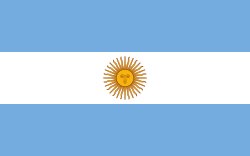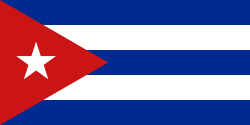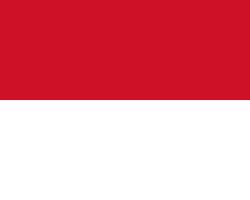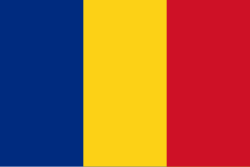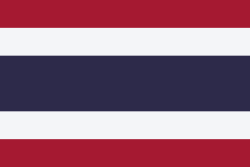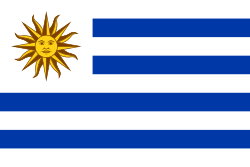Internationale racingfarver (motorsport)
 Der er for få eller ingen kildehenvisninger i denne artikel, hvilket er et problem. Du kan hjælpe ved at angive troværdige kilder til de påstande, som fremføres i artiklen.
Der er for få eller ingen kildehenvisninger i denne artikel, hvilket er et problem. Du kan hjælpe ved at angive troværdige kilder til de påstande, som fremføres i artiklen.

Fra begyndelsen af organiserede motorsportsbegivenheder, i begyndelsen af 1900'erne, indtil slutningen af 1960'erne, inden kommercielle sponsorater blev almindeligt anvendt, blev biler i internationale motorsport konkurrencer malet i standardiserede racingfarver, der angav oprindelseslandet for bilen eller føreren. Disse var ofte ret forskellige fra de nationale farver, der blev brugt i andre sportsgrene eller i politik.
Historie
1900'erne

Farverne har deres oprindelse i de nationale hold, der konkurrerede i Gordon Bennett Cup, som blev afholdt årligt i 1900-1905. Grev Eliot Zborowski, far til mellemkrigs motorsportslegenden Louis Zborowski, foreslog, at de nationale deltagere tildeles forskellige farver. I den første Gordon Bennett Cup i 1900 blev følgende farver tildelt: Blå til Frankrig, Gul til Belgien, Hvid til Tyskland og rød til De Forenede Stater. Italien benyttede ikke den berømte 'Rosso Corsa', før en rød Fiat vandt Frankrigs Grand Prix i 1907.
Da Storbritannien først deltog i løbet i 1902, måtte de vælge en anden farve end dets nationale farver i rød, hvid og blå, da disse allerede var tildelt. Selwyn Edges vindende Napier i 1902 blev malet olivengrøn, og grøn var allerede brugt som en passende farve til lokomotiver og maskiner, hvor Storbritannien havde været førende i verden i løbet af det forrige århundrede. Da Storbritannien var vært for Gordon Bennett Cup 1903 året efter, på en lukket bane i Athy i Irland, valgte briterne 'Shamrock green', som senere udviklede sig til forskellige nuancer af ' Britisk Racing Green '.
1920'erne - 1960'erne

Farverne blev videreført i mellemkrigstiden i Grand Prix-motorsport og AiACr (forløberen for FIA) havde lister over farverne. De franske Bugatti'er malet i Bleu de France og italienske Alfa Romeo'er, malet i Rosso Corsa vandt mange løb, mens de britiske Bentleyer, malet i British Racing Green dominerede Le Mans Grand Prix d'Endurance indtil 1930.
I 1930'erne anvendte Mercedes-Benz og Auto Union holdene ikke den traditionelle tyske hvide maling, og deres blanke metalplader gav anledning til udtrykket 'Sølvpilene'. En myte kom frem i 1930'erne om, at Mercedes ikke anvendte maling på grund af behovet for at være under den maksimale vægtgrænse på 750 kg, dog konkurrerede de første 'Sølvpile' i 1932, inden vægtgrænsen blev indført i 1934. Datidens moderne flydesign brugte allerede polerede og umalede aluminiumspaneler i denne periode, og det velhavende motorsportsmiljø ville også have været klar over, at hvid og sølv i Heraldik er den samme farve eller 'tinktur', beskrevet som 'Argent'. På lignende måde kaldes gul og guld begge 'Or'.
Efterkrigsfarverne blev defineret med hensyn til karosseri, motorhjelm, chassis, nummer og deres baggrunde (se diagrammer nedenfor). Da designet af racerbilerne på et tidspunkt ikke længere var synligt, blev chassisfarven vist på forskellige måder, f.eks. de parallelle blå striber fra Cunningham-teamet og andre amerikanske hold i 1950'erne. Porsche i 1950'erne og 1960'erne bevarede også sølvfarven, selvom andre tyske hold i 1960'erne (som BMW) vendte tilbage til den hvide maling.
I denne periode blev farven ikke bestemt af det land, hvor bilen blev fremstillet, og heller ikke af førerens nationalitet, men af det hold, som racerbilen repræsenterede, f.eks. kørte Stirling Moss tre løb i løbet af 1954-sæsonen i en britisk racinggrøn Maserati 250F, fordi den italienske bil blev tilmeldt af de britiske hold Equipe Moss og AEMoss . Denne generelle regel blev imidlertid ikke strengt opretholdt. For eksempel brugte Australske Jack Brabham og New Zealandske Bruce McLaren, som begge baserede[1] og licenserede deres hold i Storbritannien, farveskemaer på deres tidlige biler, der ikke var baseret på nationale farvetemaer (nemlig Brabham BT3, McLaren M2B, McLaren M4B og McLaren M5A biler).
Sponsoreringstid - fra 1968
I foråret 1968 blev sponsorater, som allerede var blevet brugt i USA i nogle år, også tilladt i international racing. Team Gunston, et sydafrikansk privathold, var det første Formel 1-team, der malede deres biler i deres sponsorers farver, da de tilmeldte en privat Brabham med John Love som kører, malet i farverne på Gunston-cigaretter, i det sydafrikanske Grand Prix i 1968.[2] I det næste løb, det spanske Grand Prix fra 1968, blev Team Lotus det første fabriksteam, der fulgte dette eksempel, med Graham Hills Lotus 49B som blev tilmeldt i de røde, guld-og hvide farver i Imperial Tobacco's Gold Leaf-mærke. Britiske Racing Green forsvandt snart fra bilerne på de britiske hold.
FIA holdt op med at benytte de gamle farver i de fleste racerdiscipliner i 1970'erne.
Samtidig brug
De traditionelle farver bruges stadig af bilproducenter og hold, der ønsker at fremhæve deres racetraditioner, især af italienske, britiske og tyske producenter.
Rosso Corsa benyttes stadig af de italienske bilproducenter Ferrari og Alfa Romeo.
Siden 1990'erne er andre traditionelle farver dukket op igen, såsom de britiske racinggrønne Formel 1-biler fra Jaguar Racing og Aston Martin- sportsvogne og den hvide Formel 1-racer fra BMW Sauber . Tyske producenter som Mercedes-Benz og Audi (Auto Union) brugte sølvmaling, da de vendte tilbage til international racing i 1990'erne. Mange konceptbiler følger de traditionelle farveskemaer, og mange amatørkører foretrækker dem også.
Sponsoraftaler respekterer ofte de traditionelle farver. For eksempel har Ferrari haft store sponsorer, der også bruger røde farver, f.eks. Marlboro og Santander. I modsætning hertil, da tobaksfirmaet West sponsorerede McLaren i 1990'erne og 2000'erne, brugte de ikke deres egne farver, men sølvfarven fra Mercedes. I en omvendt situation har Subaru fortsat med at bruge blå og gule farver efter at deres '555'-sponsoraftale sluttede.
Nogle bilproducenter bruger farver, der er forskellige fra det traditionelle farveskema. For eksempel har Citroën traditionelt brugt rød, Renault og Opel har brugt gul og sort, og Volkswagen har brugt blå og hvid.
Nations Cup, som som blev kørt 1990 – 1998, var en mærkeserie, hvor ca. 20 nationale hold var repræsenteret.[3]
Den årlige A1 Grand Prix-serie, som blev kørt 2005 – 2009 blev kørt med nationale hold, der kørte identiske biler med forskellige farvekombinationer. Oprindeligt var de fleste farvekombinationer baseret på de respektive nationers flag.[4] Nogle hold med forskellige traditionelle sportsfarver har efterfølgende skiftet farver, f.eks. 'A1 Team Australia'[5] og 'A1 Team India'.[6] De gamle nationale racingfarver var ikke så populære blandt disse hold.

Hondas Type-R biler sælges i 'Championship White' (Honda farvekode NH0), der svarer til den originale hvide, der prydede Hondas første Formel 1 bil (Honda RA272) kørt af Richie Ginther, der sikrede Hondas første Formel 1 sejr i det Mexicanske Grand Prix, 1965 .
Historiske farver
Større konkurrenter
Nedenstående farvekombinationer har holdt sig igennem tiderne og er også almindeligt kendt uden for international Grand Prix racing.


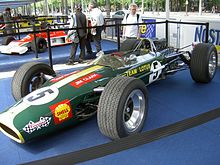

| Kode | Land | Karossseri | Numre | Mærker / Hold |
|---|---|---|---|---|
| D | Hvid[7] | Rød | Benz, Mercedes, BMW, Porsche, Audi | |
| Sølv eller metal (Sølvpilene) | Rød | Mercedes-Benz, Auto Union, Veritas, Borgward, EMW, Porsche, Audi | ||
| F | Blå (Bleu de France) | Hvid | Delage, Bugatti, Talbot, Delahaye, Matra, Panhard, Alpine, Gordini, Peugeot, Ballot, Ligier | |
| GB | Grøn (Britisk Racing Green) | Hvid | Jaguar, Vanwall, Cooper, Lotus, Brabham, BRM, Bentley, Aston Martin, MG, Caterham | |
| I | Rød (Rosso corsa) | Hvid | Alfa Romeo, Maserati, Ferrari, Lancia, Abarth, OSCA, Officine Meccaniche | |
| J | Hvid med rød "sol" | Sort | Honda, Nissan, Toyota, Super Aguri | |
| USA | Hvide, blå langsgående striber ("Cunningham racing stripes"), blå chassis | Blå | Cunningham, Ford, NART, Shelby, Chaparral, Hendrick | |
| Blå (Imperialblå), hvide langsgående striber, hvidt chassis | Hvid | AAR Eagle, Ford, Shelby, Scarab, Chevrolet, Hendrick |
National liste
Følgende farvekombinationer er blevet vedtaget for nedenstående lande på forskellige tidspunkter: [8] [9] [10] [11]
| Code | Country | Karosseri | Kølerhjelm | Andre farver | Numre | Illustreret eksempel |
|---|---|---|---|---|---|---|
| A | Blå | Sort på hvid | ||||
| ARG | Blå | Gul | Chassis: Sort | Rød på hvid | ||
| AUS | Grøn | Guld | Blå | Sort | ||
| B | Gul | Sort | ||||
| BR | Lys gul | Chassis/hjul: Grøn Nogle brasilianske biler havde langsgående grønne striber | Sort | |||
| BUL | Grøn | Hvid | Rød på hvid | |||
| C | Gul | Sort | Sort på hvid | |||
| CDN | De traditional farver er British Racing Green med to langsgående hvide striber (4" bred og 6" afstand) | Efter at det canadiske flag blev valgt i 1965 blev det populært med røde biler med hvide langsgående striber | Sort | |||
| CH | Rød | Hvid | Sort | |||
| CS | Hvid | Blå/hvid | Chassis: Rød | Blå | ||
| D | Hvid | Metal, 'Sølvpilene' | Rød | |||
| DK | Sølvgrå | Dannebrog på langs af kølerhjelm | Rød på hvid | |||
| E | Rød | Gul | Chassis/fjedre: Rød | Sort på gul eller hvid på rød | ||
| ET | Lys violet | Rød på hvid | ||||
| F | Blå | Hvid | ||||
| FIN | Hvid | Tre striber på kølerhjelm som danner et latinerkors | Sort på hvid | |||
| GB | Grøn | Den skotske kører Rob Walker brugte mørk blå med hvid snude og Ecurie Ecosse brugte også den mørke blå; the Arrol Johnston-holdet (pre-1. verdenskrig) brugte en blå skotsktern | Hvid | |||
| GR | Lys blå | To hvide langsgående striber | Sort på hvid | |||
| H | Front: Hvid Bag: Grøn | Rød | Sort | |||
| HJK | Brun | Sort på hvid | ||||
| I | Rød | Hvid | ||||
| IRL | Grøn | Orange, horisontalt bånd hele vejen rundt | Hvid | |||
| J | Elfenbenshvid | Rød cirkel på motorhjelm | Hvid på sort | |||
| L | Langsgående tricolore (rød/hvid/blå) | Sort på hvid | ||||
| MAS | Gul | Hvid | Sort på hvid/sort | |||
| MC | Hvid | Rødt, horisontalt bånd hele vejen rundt | Sort på hvid | |||
| MEX | Guld | Forskellige designs i kongeblå, ikke kun X på kølerhjelm | Sort på hvid, ikke rød på hvid | |||
| NL | Orange | Hvid | ||||
| NZ | Grøn og sølv | Sort og sølv[12] | ||||
| PHI | Rød | Blå | Rød | |||
| P | Rød | Chassis: Hvid | Hvid | |||
| PL | Hvid | Chassis: Rød | Rød på hvid | |||
| RCH | Rød | Blå | Chassis: Hvid | Blå/rød eller rød på hvid | ||
| RO | Navy blå | Chassis: Rød | Gul | |||
| RUS | Gul | Rød i sovjet-perioden | Sort | |||
| S | Blå bund, gul top, 3 tværgående striber på kølerjhjelm | Hvid | ||||
| T | Lys blå med gul vandret stribe på karosse og kølerhjelm | Hjul: lys gul | Hvid på blå | |||
| U | Lys blå med bred rød stribe på den nederste del af kølerhjelm | Hvid på sort | ||||
| USA | Hvid med langsgående blå striber | Chassis: blå | Blå på hvid | |||
| ZA | Guld | Grøn | Sort på gul | |||
Referencer
- ^ "Case History". Corktree.tripod.com. Hentet 2017-09-07.
- ^ "'SA was ahead of the curve' - 50 years of sponsorship in F1". wheels24.co.za. Hentet 4. oktober 2018.
- ^ "Archived copy". Arkiveret fra originalen 12. august 2007. Hentet 2007-08-12.
{{cite web}}: CS1-vedligeholdelse: Arkivtitel brugt (link) Fastlines International - ^ "Sporting Regulations". A1 GP. Arkiveret fra originalen 24. maj 2008. Hentet 1. september 2008.
- ^ "Australia's new colours". A1 GP. 28. august 2008. Arkiveret fra originalen 31. august 2008. Hentet 1. september 2008.
- ^ "A1 Team India brings home 2 points with 9th position in the Feature Race". A1 Team India. 14. oktober 2007. Arkiveret fra originalen 14. marts 2008. Hentet 1. september 2008.
- ^ Ahlbom, red. (1948). "Motorsport". Sportens lille jätte (svensk). Stockholm: Natur & Kultur. s. 746.
- ^ "International Racing Colours". Arkiveret fra originalen 2. december 2013.
- ^ "Racing Colors English". www.modelersite.com. Hentet 4. oktober 2018.
- ^ "Vintage FIA Colours". Arkiveret fra originalen 18. februar 2020. Hentet 16. marts 2020.
- ^ "Motorsport Memorial - Miscellaneous - Country abbreviations and racing colours".
- ^ Doug Nye: "McLaren, The Grand Prix, Can-Am and Indy Cars", page 73
McLaren - The Cars by model number Arkiveret 17. juni 2007 hos Wayback Machine
Yderligere læsning
- Davey, Keith Davey (1969). The encyclopaedia of motor racing. Anthony Pritchard. D. McKay Co.
Eksterne links
- "The colour in racing". Road & Track. 1960. http://www.miata.net/misc/racecolor.html
Medier brugt på denne side
Flag of Austria with the red in the Austrian national colours which was official ordered within the Austrian Armed Forces (Bundesheer) in the characteristic “Pantone 032 C” (since May 2018 the Red is ordered in the characteristic “Pantone 186 C”.)
Flag of Canada introduced in 1965, using Pantone colors. This design replaced the Canadian Red Ensign design.
Finlands flag
Flag of Portugal, created by Columbano Bordalo Pinheiro (1857–1929), officially adopted by Portuguese government in June 30th 1911 (in use since about November 1910). Color shades matching the RGB values officially reccomended here. (PMS values should be used for direct ink or textile; CMYK for 4-color offset printing on paper; this is an image for screen display, RGB should be used.)
Det er let at give dette billede en kant
The national flag of Kingdom of Thailand; there are total of 3 colours:
- Red represents the blood spilt to protect Thailand’s independence and often more simply described as representing the nation.
- White represents the religion of Buddhism, the predominant religion of the nation
- Blue represents the monarchy of the nation, which is recognised as the centre of Thai hearts.
Used color: National flag | South African Government and Pantone Color Picker
| grøn | rendered as RGB 0 119 73 | Pantone 3415 C |
| gul | rendered as RGB 255 184 28 | Pantone 1235 C |
| rød | rendered as RGB 224 60 49 | Pantone 179 C |
| blå | rendered as RGB 0 20 137 | Pantone Reflex Blue C |
| hvid | rendered as RGB 255 255 255 | |
| sort | rendered as RGB 0 0 0 |
Forfatter/Opretter: John Harwood, Licens: CC BY 2.0
Prince Bira of Siam's English Racing Automobiles R12B racing car, "Hanuman II", pictured in the national racing colours of Siam (later Thailand) of pale blue with yellow chassis and wheels. This photo appears to have been taken at a historic race meeting some time in the 1980s. In the late 1930s Prince Bira and his cousin Prince Chula of Siam owned three ERA cars. Hanuman was their third, and the first to wear the blue-and-yellow of Siam in place of Prince Bira's earlier single colour "Bira Blue" scheme. All were run by their Whitemouse Garage racing team, whose emblem can be seen on Hanuman II, just ahead of the cockpit opening and adjacent to this car's distinctive raised 'Hanuman' emblem in silver. R12B was rebuilt as a C-Type car in 1937, and renumbered R12C, prior to being sold to Chula and Bira who named it "Hanuman". However, following a major accident in 1939 the car was rebuilt again and reverted to a B-Type chassis. It was thus renumbered back to R12B, and in light of this major rebuild Bira renamed the car "Hanuman II". As of 2007 this car is the property of the King of Thailand. This car is not to be confused with R12C Hanuman, which was built in the 1980s using the damaged C-Type chassis and discarded parts from the post-accident rebuild that formed Hanuman II.
Forfatter/Opretter: No machine-readable author provided. Kzaral~commonswiki assumed (based on copyright claims)., Licens: CC BY-SA 3.0
Illustrated example of Spanish racing color. Drawn by Kzaral. The shape roughly based on this GFDL image.
Forfatter/Opretter: No machine-readable author provided. Kzaral~commonswiki assumed (based on copyright claims)., Licens: CC BY-SA 3.0
Illustrated example of Austrian racing color. Drawn by Kzaral. The shape roughly based on this GFDL image.
Forfatter/Opretter: No machine-readable author provided. Kzaral~commonswiki assumed (based on copyright claims)., Licens: CC BY-SA 3.0
Illustrated example of German racing color. Drawn by Kzaral. The shape roughly based on this GFDL image.
Forfatter/Opretter: No machine-readable author provided. Kzaral~commonswiki assumed (based on copyright claims)., Licens: CC BY-SA 3.0
Illustrated example of Irish racing color. Drawn by Kzaral. The shape roughly based on this GFDL image.
Forfatter/Opretter: No machine-readable author provided. Kzaral~commonswiki assumed (based on copyright claims)., Licens: CC BY-SA 3.0
Illustrated example of Bulgarian racing color. Drawn by Kzaral. The shape roughly based on this GFDL image.
Forfatter/Opretter: No machine-readable author provided. Kzaral~commonswiki assumed (based on copyright claims)., Licens: CC BY-SA 3.0
Illustrated example of Finnish racing color. Drawn by Kzaral. The shape roughly based on this GFDL image.
Forfatter/Opretter: No machine-readable author provided. Kzaral~commonswiki assumed (based on copyright claims)., Licens: CC BY-SA 3.0
Illustrated example of Egyptian racing color. Drawn by Kzaral. The shape roughly based on this GFDL image.
Forfatter/Opretter: No machine-readable author provided. Kzaral~commonswiki assumed (based on copyright claims)., Licens: CC BY-SA 3.0
Illustrated example of Australian racing color. Drawn by Kzaral. The shape roughly based on this GFDL image.
Forfatter/Opretter: No machine-readable author provided. Kzaral~commonswiki assumed (based on copyright claims)., Licens: CC BY-SA 3.0
Illustrated example of Uruguayan racing color. Drawn by Kzaral. The shape roughly based on this GFDL image.
Forfatter/Opretter: No machine-readable author provided. Kzaral~commonswiki assumed (based on copyright claims)., Licens: CC BY-SA 3.0
Illustrated example of Brazilian racing color. Drawn by Kzaral. The shape roughly based on this GFDL image.
Forfatter/Opretter: Lars-Göran Lindgren Sweden, Licens: CC BY-SA 3.0
Bugatti Type 35C Grand Prix Racer 1926
Forfatter/Opretter: No machine-readable author provided. Kzaral~commonswiki assumed (based on copyright claims)., Licens: CC BY-SA 3.0
Illustrated example of Belgian racing color. Drawn by Kzaral. The shape roughly based on this GFDL image.
Forfatter/Opretter: Deep silence (Mikaël Restoux), Licens: CC BY-SA 3.0
F1 Lotus 49 (early version)
Forfatter/Opretter: No machine-readable author provided. Kzaral~commonswiki assumed (based on copyright claims)., Licens: CC BY-SA 3.0
Illustrated example of South African racing color. Drawn by Kzaral. The shape roughly based on this GFDL image.
Forfatter/Opretter: No machine-readable author provided. Kzaral~commonswiki assumed (based on copyright claims)., Licens: CC BY-SA 3.0
Illustrated example of French racing color. Drawn by Kzaral. The shape roughly based on this GFDL image.
Forfatter/Opretter: No machine-readable author provided. Kzaral~commonswiki assumed (based on copyright claims)., Licens: CC BY-SA 3.0
Illustrated example of New Zealand racing color. Drawn by Kzaral. The shape roughly based on this GFDL image.
Forfatter/Opretter: Marcin Wichary, Licens: CC BY 2.0
Fittipaldi F5A
Forfatter/Opretter: Jsobral, Licens: CC BY-SA 3.0
Polish auto racing color
Forfatter/Opretter: Jsobral, Licens: CC BY-SA 3.0
Czechoslovak auto racing color
Forfatter/Opretter: No machine-readable author provided. Kzaral~commonswiki assumed (based on copyright claims)., Licens: CC BY-SA 3.0
Illustrated example of British racing color. Drawn by Kzaral. The shape roughly based on this GFDL image.
Forfatter/Opretter: No machine-readable author provided. Kzaral~commonswiki assumed (based on copyright claims)., Licens: CC BY-SA 3.0
Illustrated example of Cuban racing color. Drawn by Kzaral. The shape roughly based on this GFDL image.
Forfatter/Opretter: No machine-readable author provided. Kzaral~commonswiki assumed (based on copyright claims)., Licens: CC BY-SA 3.0
Illustrated example of Hungarian racing color. Drawn by Kzaral. The shape roughly based on this GFDL image.
Forfatter/Opretter: No machine-readable author provided. Kzaral~commonswiki assumed (based on copyright claims)., Licens: CC BY-SA 3.0
Illustrated example of Canadian racing color. Drawn by Kzaral. The shape roughly based on this GFDL image.
Forfatter/Opretter: No machine-readable author provided. Kzaral~commonswiki assumed (based on copyright claims)., Licens: CC BY-SA 3.0
Illustrated example of Japanese racing color. Drawn by Kzaral. The shape roughly based on this GFDL image.
Forfatter/Opretter: No machine-readable author provided. Kzaral~commonswiki assumed (based on copyright claims)., Licens: CC BY-SA 3.0
Illustrated example of Dutch racing color. Drawn by Kzaral. The shape roughly based on this GFDL image.
Forfatter/Opretter: No machine-readable author provided. Kzaral~commonswiki assumed (based on copyright claims)., Licens: CC BY-SA 3.0
Illustrated example of Monégasque racing color. Drawn by Kzaral. The shape roughly based on this GFDL image.
Forfatter/Opretter: No machine-readable author provided. Kzaral~commonswiki assumed (based on copyright claims)., Licens: CC BY-SA 3.0
Illustrated example of Jordanian racing color. Drawn by Kzaral. The shape roughly based on this GFDL image.
Forfatter/Opretter: Jsobral, Licens: CC BY-SA 3.0
Chile auto racing color
Forfatter/Opretter: No machine-readable author provided. Kzaral~commonswiki assumed (based on copyright claims)., Licens: CC BY-SA 3.0
Illustrated example of Italian racing color. Drawn by Kzaral. The shape roughly based on this GFDL image.
Forfatter/Opretter: No machine-readable author provided. Kzaral~commonswiki assumed (based on copyright claims)., Licens: CC BY-SA 3.0
Illustrated example of U.S. racing color. Drawn by Kzaral. The shape roughly based on this GFDL image.
Forfatter/Opretter: No machine-readable author provided. Kzaral~commonswiki assumed (based on copyright claims)., Licens: CC BY-SA 3.0
Illustrated example of Swiss racing color. Drawn by Kzaral. The shape roughly based on this GFDL image.
Forfatter/Opretter: No machine-readable author provided. Kzaral~commonswiki assumed (based on copyright claims)., Licens: CC BY-SA 3.0
Illustrated example of Malaysian racing color. Drawn by Kzaral. The shape roughly based on this GFDL image.
Forfatter/Opretter: tomislav medak, Licens: CC BY-SA 2.0
1925 Itala II V12 1050 cc L'evoluzione dell'automobile
Forfatter/Opretter: No machine-readable author provided. Kzaral~commonswiki assumed (based on copyright claims)., Licens: CC BY-SA 3.0
Illustrated example of Argentinian racing color. Drawn by Kzaral. The shape roughly based on this GFDL image.
Forfatter/Opretter: Kyuzoaoi, Licens: CC BY-SA 3.0
International autoracing colors for Monaco. Based on User:Kazral's http://en.wikipedia.org/wiki/File:Auto_racing_color_I.png.
Forfatter/Opretter: No machine-readable author provided. Kzaral~commonswiki assumed (based on copyright claims)., Licens: CC BY-SA 3.0
Illustrated example of Swedish racing color. Drawn by Kzaral. The shape roughly based on this GFDL image.
Goodwood Festival of Speed 2007 -
Auto Union and Mercedes silver arrows prepare for startForfatter/Opretter: Stephen Hanafin, Licens: CC BY-SA 2.0
Mercedes-Benz "Blitzen Benz" racing car
Forfatter/Opretter: Kyuzoaoi, Licens: CC BY-SA 3.0
This is an example of Philippine Auto Racing Colors. The information is based from http://basementgeographer.blogspot.ca/2012/03/international-racing-colours.html#!/2012/03/international-racing-colours.html. The basis is a drawing by User:Kazral named http://en.wikipedia.org/wiki/File:Auto_racing_color_I.png.
Forfatter/Opretter: No machine-readable author provided. Kzaral~commonswiki assumed (based on copyright claims)., Licens: CC BY-SA 3.0
Illustrated example of Danish racing color. Drawn by Kzaral. The shape roughly based on this GFDL image.
Forfatter/Opretter: No machine-readable author provided. Kzaral~commonswiki assumed (based on copyright claims)., Licens: CC BY-SA 3.0
Illustrated example of Greek racing color. Drawn by Kzaral. The shape roughly based on this GFDL image.
Forfatter/Opretter: No machine-readable author provided. Kzaral~commonswiki assumed (based on copyright claims)., Licens: CC BY-SA 3.0
Illustrated example of Luxembourg racing color. Drawn by Kzaral. The shape roughly based on this GFDL image.
(c) Jaydec at engelsk Wikipedia, CC BY-SA 3.0
1964 Shelby Daytona Cobra Coupe (CSX2299), 2010 Canadian International AutoShow.








